The 'sawbill' ducks are a strange group, their slim, saw-toothed bills supremely adapted to catching fish underwater. There are only six extant species in the world, two of which (Brazilian and Scaly-sided Mergansers) are beyond the scope of this article, but the other four species are all on the British list. They fall logically into two species pairs: one large and the other small.
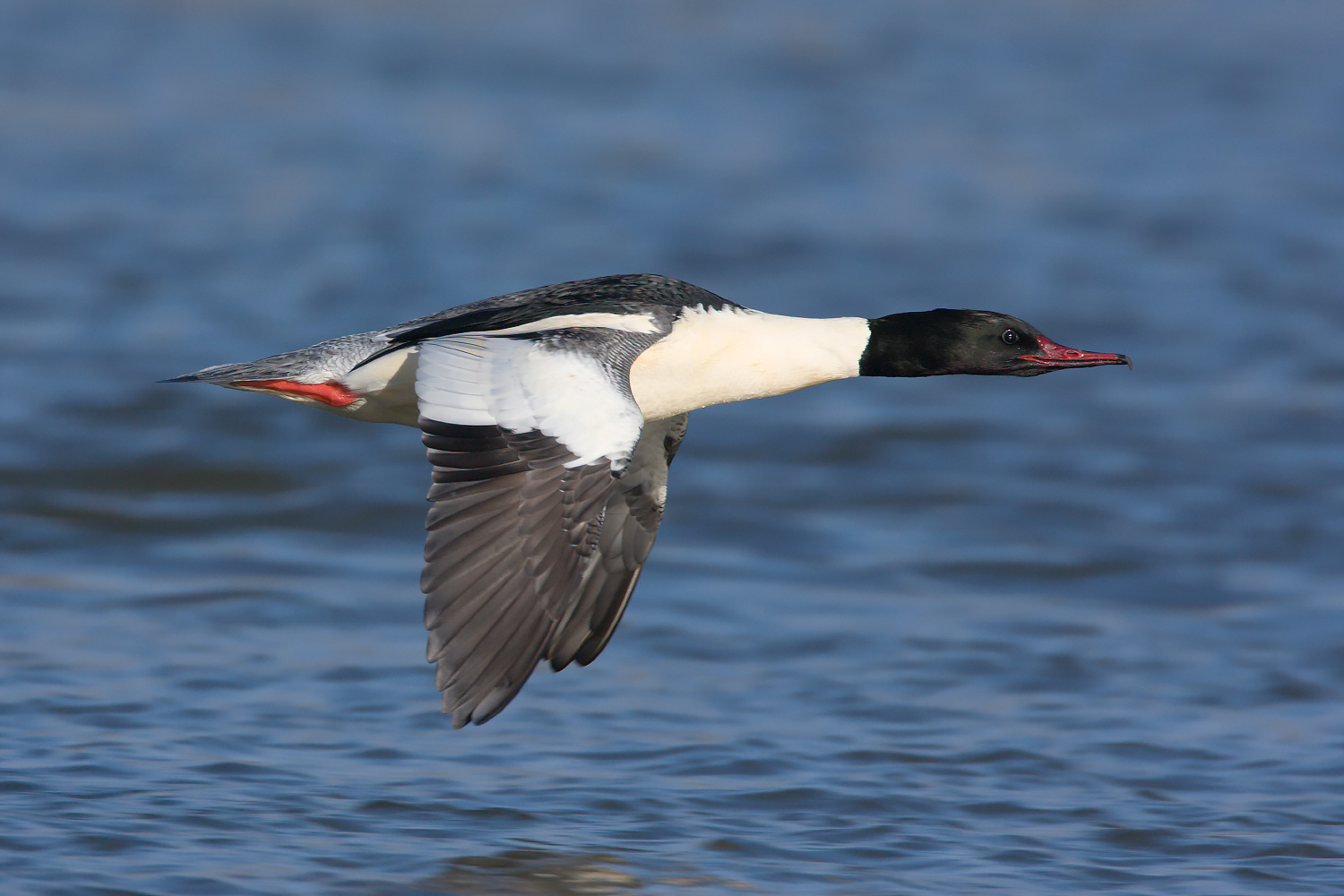
Goosander (Roermond Asselt, The Netherlands, 26 January 2008). Sawbills are unusual ducks, not only in their long, thin, serrated bills – very different from the traditional broad spatulate duck shape – but also in their highly contrasting plumages. This beautiful flying Goosander shows both these aspects to perfection (Ran Schols / www.agami.nl).
Red-breasted Merganser
This is our most familiar 'sawbill', a breeding bird in Scotland, northern England and Wales, and a reasonably common winterer throughout the rest of Britain, where it is almost exclusively marine, occurring in sheltered shallow inshore waters, typically in estuaries. There is also some migration in winter from continental populations. Its world range extends throughout the Holarctic, occupying both the Old and New Worlds, but there are no recognised subspecies.
This is a large, slim duck, in size and structure as much like a Great Crested Grebe as other ducks. Adult males are highly distinctive with their green heads, red eyes, white collars, rusty breasts and, most striking of all, a strange thin and wispy double crest. The red bill is very fine indeed, right to the base, and even appears very slightly uptilted.
Females, young and eclipse males are much drabber, brown bodied and chestnut headed, with a gradual 'blurred' transition between the neck and the body, and, up close, a diffuse pale loral line.
Goosander
This is the other member of the pair of large sawbills. Like Red-breasted Merganser, it has a large world range, breeding throughout the Palearctic and the Nearctic (where it occurs as a different subspecies known as 'Common Merganser').
In Britain it is a scarce breeder on rivers in the north and west and in winter it can be found further south too, most commonly inland on lakes, reservoirs and gravel pits where favoured sites can attract significant numbers. Compared with Red-breasted Merganser, it is much less commonly seen in coastal waters. There is also some winter migration, with occasional large arrivals fleeing hard weather in continental Europe. The North American subspecies must be a potential vagrant to Britain, but there are as yet no accepted records.
This is the largest of the British sawbills, both larger and more robust than Red-breasted Merganser, with a larger head and thicker neck. The adult males are beautiful with their dark bottle-green heads, dark eyes and exquisitely salmon-hued underparts. The red bill is fine but deeper based than that of Red-breasted Merganser.
Females, young and eclipse males are very different, essentially similar to the equivalent plumages of Red-breasted Merganser, but the border between the chestnut head and the largely grey body is abrupt, while a neat clearly defined white chin and throat are also apparent.
Smew
By contrast with the above two species, this diminutive sawbill is exclusively a winter visitor to Britain. It is confined to the Palearctic, but has a large range which extends all the way from Scandinavia in the west to the Russian Far East.
In this country it favours lakes, reservoirs and gravel pits, mainly in south-east England, but it is scarce and declining. As recently as the 1970s some sites regularly held good numbers, but today this is a scarce winter visitor anywhere. Most birds reaching Britain are 'redheads' – females or young males.
This is a very small duck, little larger than a Eurasian Teal; it is neat and compact with a short and, for a sawbill, stout bill. Arguably Britain's most beautiful duck, the adult males (sometimes known as 'White Nuns') are unmistakable: largely pure white but with a black back, grey flanks, vertical black lines on the fore-flanks, a little black within a short, loose crest crest and black 'panda eyes'.
The 'redheads' are, however, much duller – chestnut capped down to below the eye, white on the cheeks and foreneck and grey bodied, strangely reminiscent at range of a small grebe.
Hooded Merganser
Britain's fourth sawbill is a vagrant. It has a large North American breeding range, but does not nest outside the Nearctic. Its position on the British list has always been (and remains) controversial. Though doubtless occurring here as a genuine transatlantic vagrant, many (most?) occurrences relate to escapes from wildfowl collections. The problem, as ever, is disentangling the two and in the case of this species in particular this is no easy task.
Britain's first accepted individual was on North Uist, Outer Hebrides in 2000, since when a further seven have been accepted as wild (or at least potentially wild) birds, with three also on the books for Ireland. This is a mainly a bird of freshwater habitats, and British birds have been largely on lakes, reservoirs and gravel pits.
Hooded Merganser is also small and compact, though not as tiny and short billed as Smew. The adult males are eyecatching – a riot of chestnut, black and white. The head and upperparts are black with white-fringed scapulars and a highly distinctive white-centred Hoopoe-like crest, usually held depressed but dramatic when raised. The underparts are white with vertical black lines on the fore-flanks and deep chestnut flanks. The eye is a bright gold. Females, young and eclipse males are drabber – chestnut-headed and brown-bodied – but also have the distinctive erectile fan-like crest.
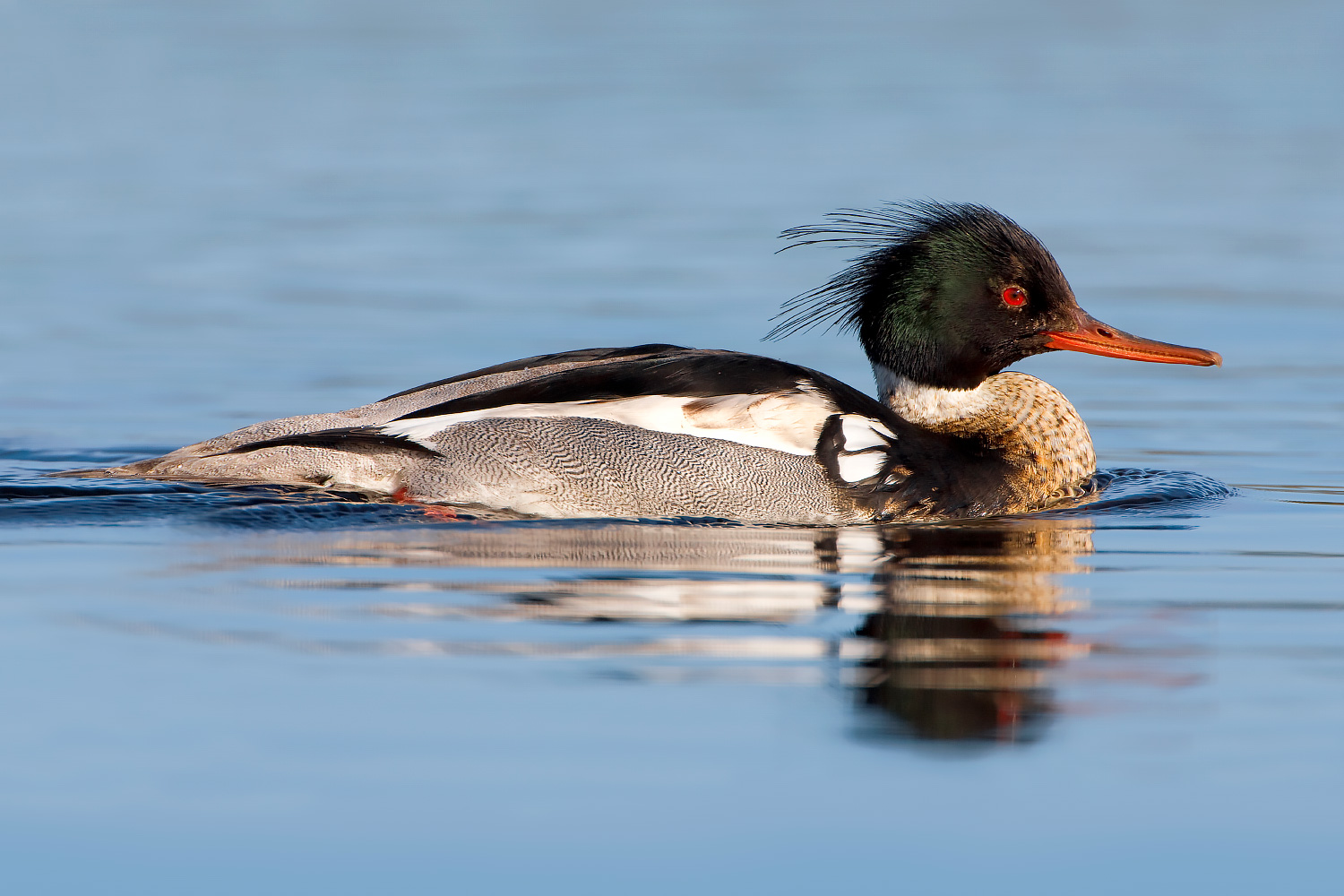
Red-breasted Merganser (Kuusamo, Finland, 4 June 2008). Adult male Red-breasted Mergansers are easy to identify but have rather complicated plumages. Note here the dark glossy green head with two wispy head plumes, white neck collar, rusty breast and black, white and grey body, all offset by bright red eyes and bill. The latter is particularly long and thin, including at the base (Daniele Occhiato / www.agami.nl).
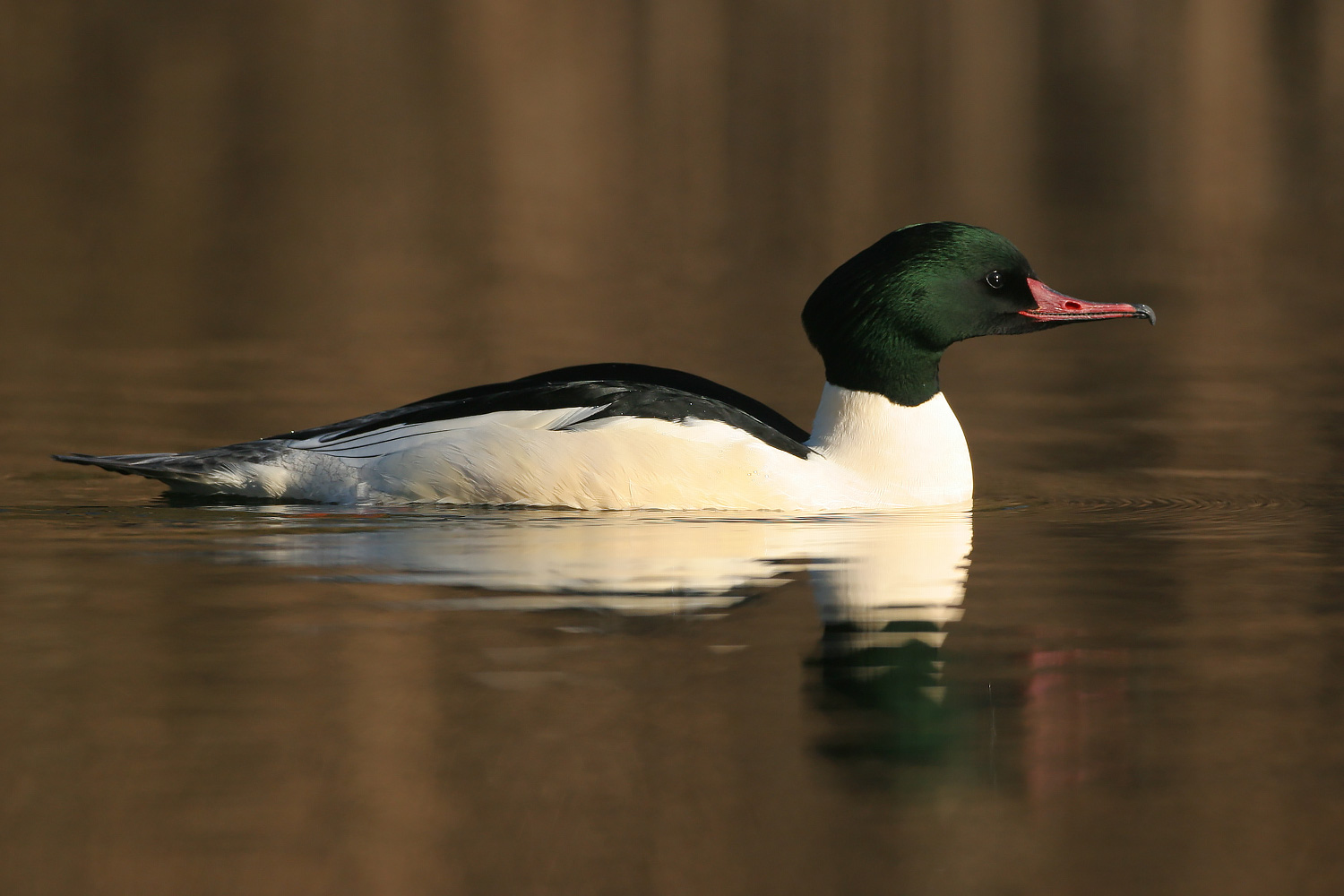
Goosander (Katwijk, The Netherlands, 3 February 2007). This adult drake Goosander looks a heavier bird than the merganser above. It lacks any head plumes, and the bill, although also long and thin, is relatively deep at the base. The eye is also dark. The plumage is striking and much simpler than that of Red-breasted Merganser, comprising a dark green head, a dark back and beautiful salmon-flushed white underparts (Menno van Duijn / www.agami.nl).
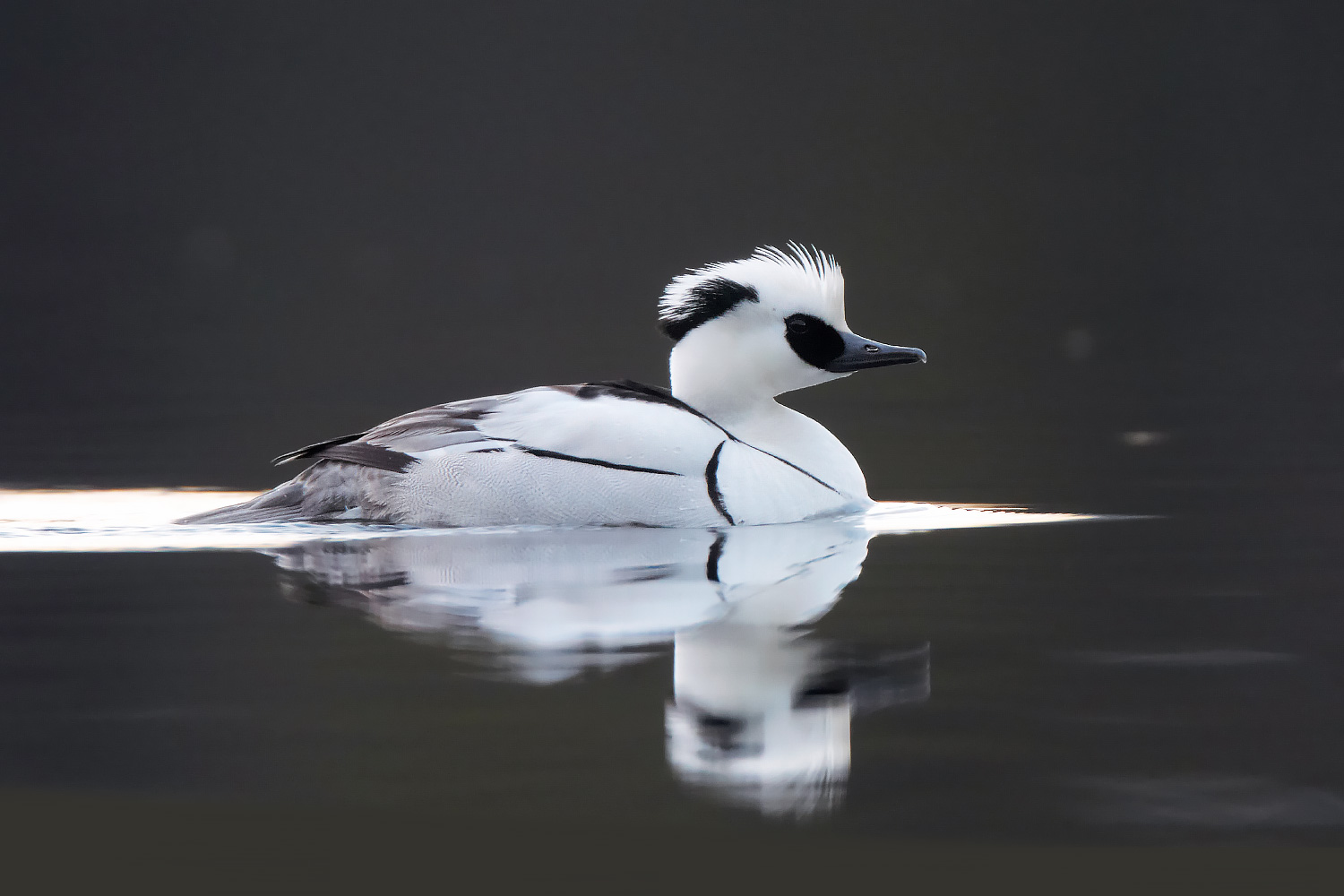
Smew (Kuusamo, Finland, 18 May 2011). Adult drake Smew is highly distinctive and perhaps our most beautiful sawbill, fully justifying its 'White Nun' nickname. The bird is essentially bright white, overlain with black 'panda eyes' and black in the nape crest, on the back and in delicate pencil-thin lines on the flanks and breast-sides. Note the relatively short and dark bill compared to its larger cousins (Markus Varesvuo / www.birdphoto.fi).
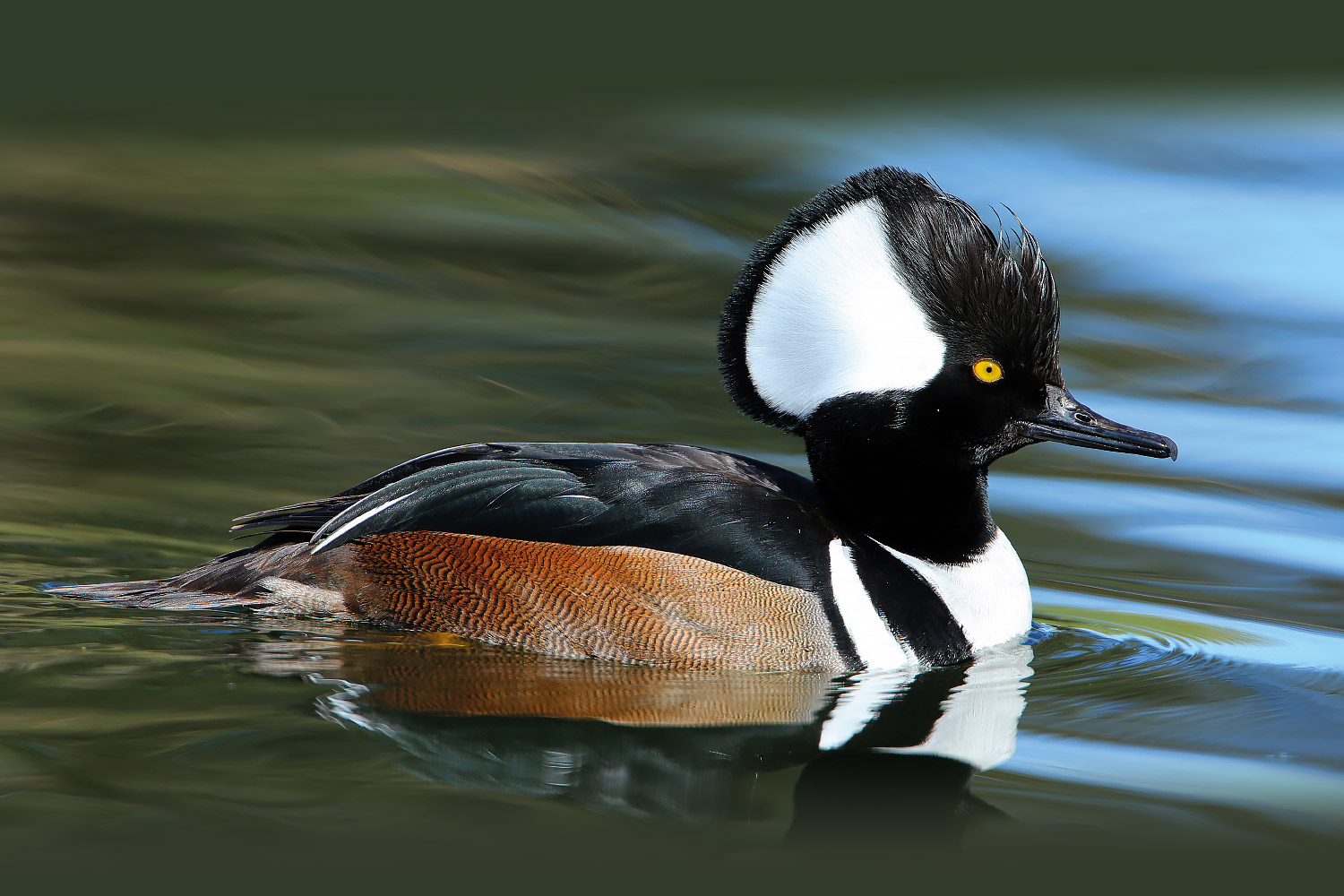
Hooded Merganser (California, USA, 1 February 2016). Just as striking is adult drake Hooded Merganser, combining a black head and upperparts with a white-centred erectile nape 'fan', white on the front and sides of the breast and rich orange flanks, the latter inlaid with delicate dark vermiculations. The dark bill is similar to that of Smew, although distinctly longer, and the eye is a bright golden yellow (Aurélien Audevard).
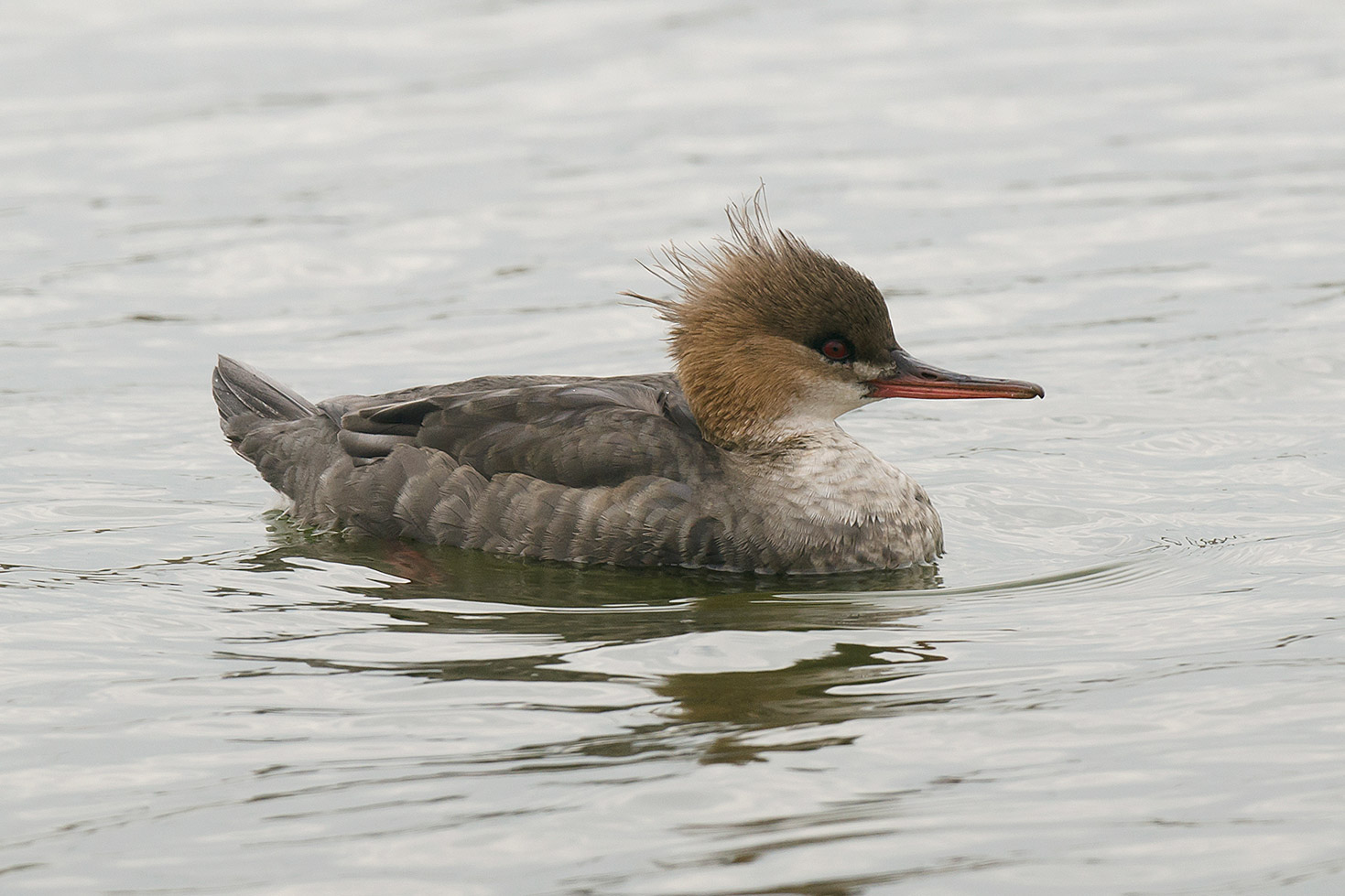
Red-breasted Merganser (Seaforth, Lancashire, 28 March 2013). Female sawbill ducks are much drabber than the drakes. This adult female Red-breasted Merganser sports a red bill and wispy rear head feathers like the male, but otherwise lacks any bright colours or adornments and the eye is quite dull also. The head is a dull, rusty orange, weakly demarcated from the whitish foreneck and grey body. Note also the short pale loral line linking the eye and the bill (Steve Young / www.birdsonfilm.com).
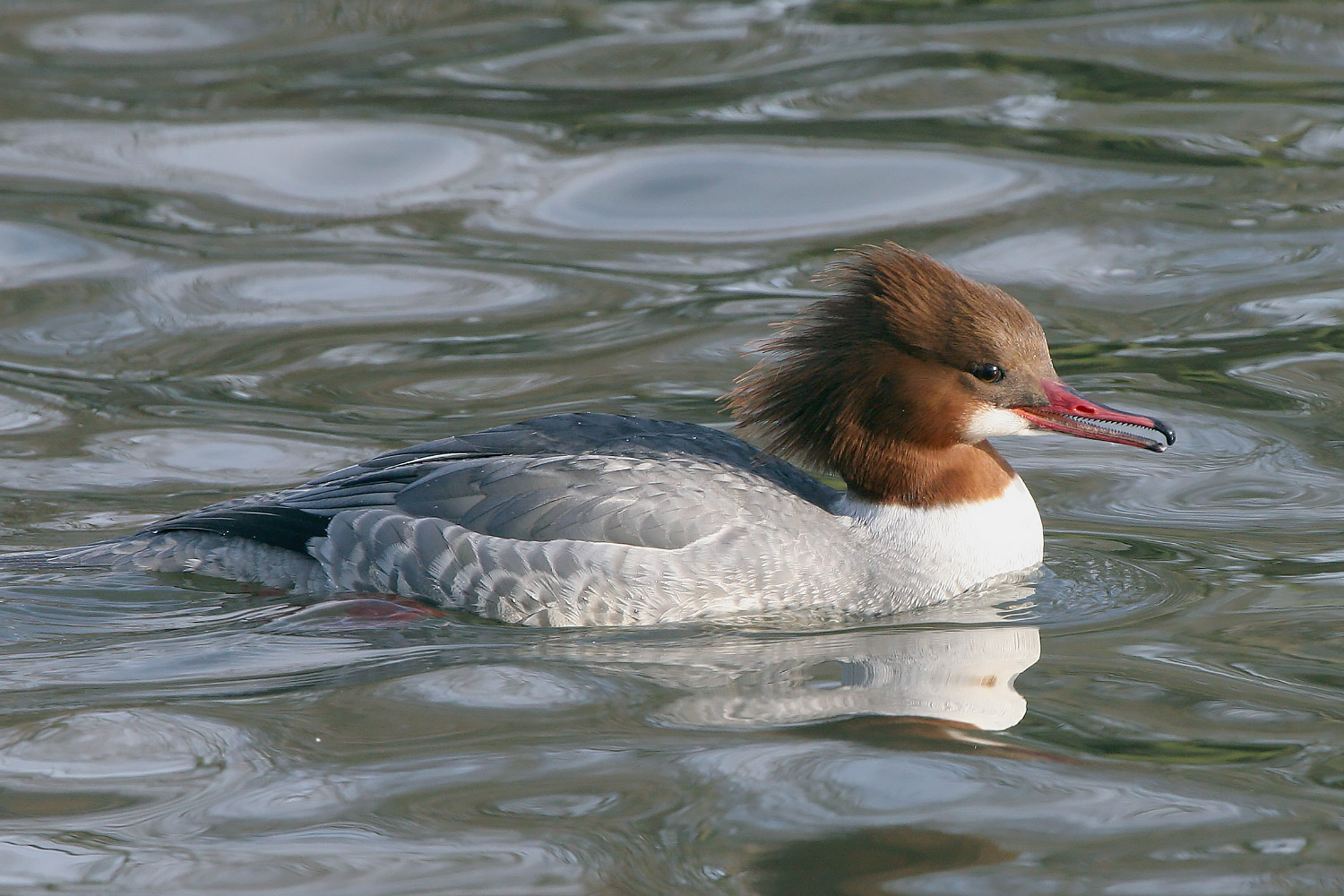
Goosander (Hull, East Yorkshire, 27 February 2008). Female Goosander is similarly dull, lacking any green in the head and, like Red-breasted Merganser, painted in more subtle hues of rusty orange, grey and white. However, the head pattern is sharper and more contrasting: note the neat clearly defined white throat and the sharp demarcation between the rusty orange head and white foreneck. There is also no sign of a pale loral line. The dark eye and fresh, round-tipped grey tertials with black outer fringes identify this bird as an adult (Michael Ashforth).
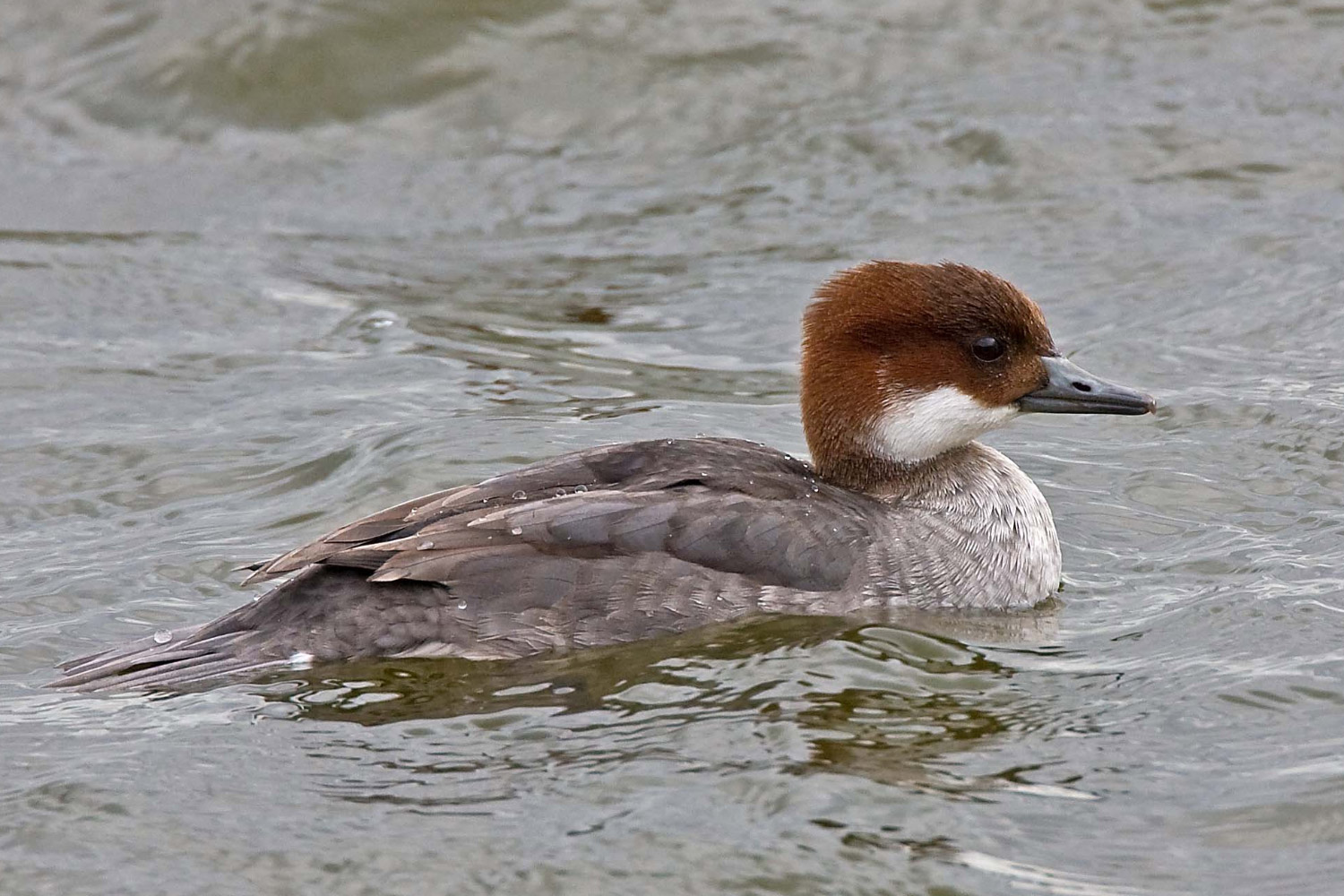
Smew (Welney WWT, Norfolk, 6 March 2008). Female Smew continues the rusty orange, grey and white theme, but the head pattern is rather different, comprising a dark orange cap extending down across the lores and ear coverts and contrasting sharply with a bright white chin and throat. The rest of the body is grey. Note also the neat, compact proportions and the short, dark bill. The concolorous lores and 'fore-face' of this bird (not noticeably darker than the rest of the head) indicate that this is likely to be a young bird. There are further ageing clues in the wing pattern, but these are not visible here (Garth Peacock).
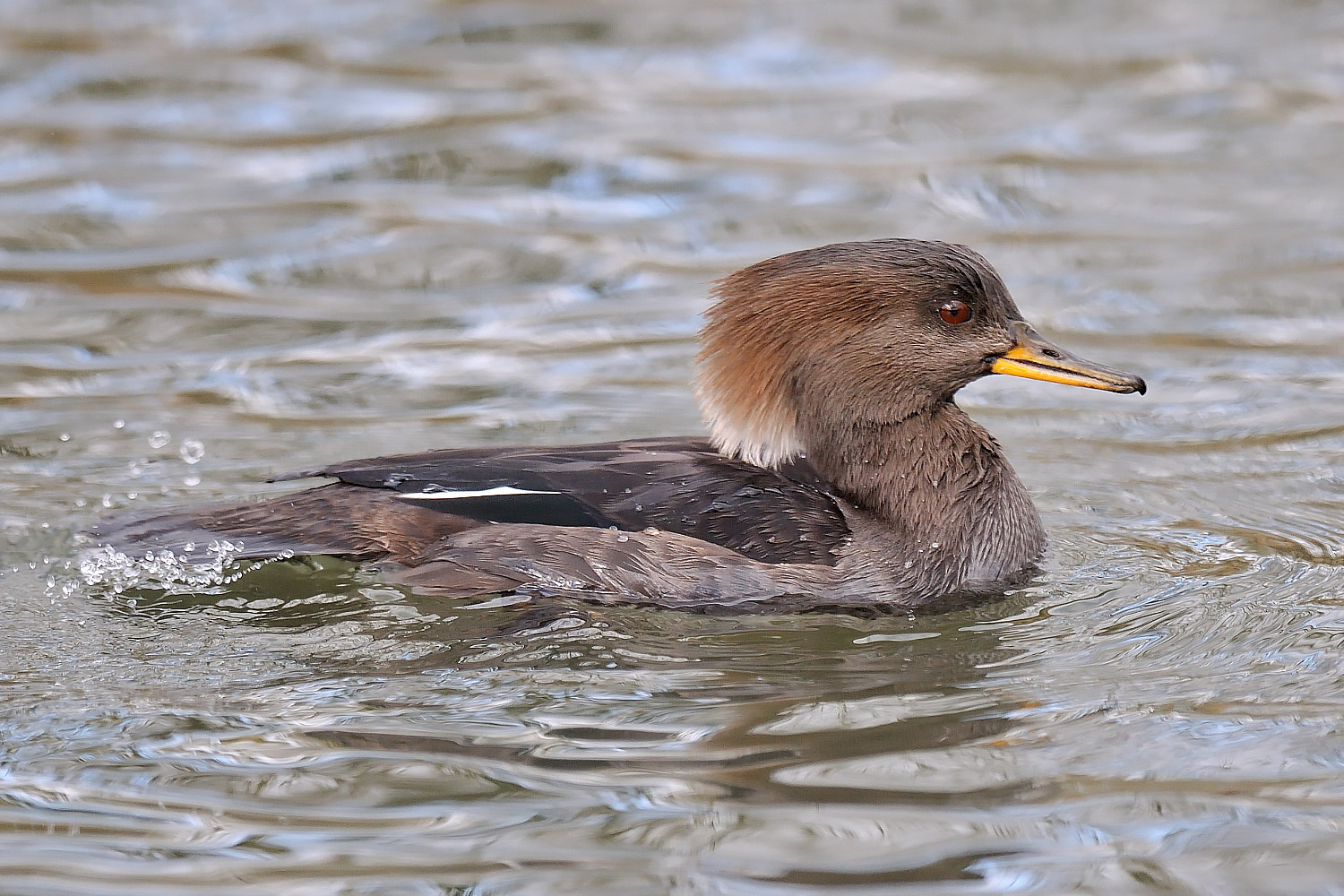
Hooded Merganser (Corsham Park, Wiltshire, 25 February 2016). Female Hooded Mergansers retain the erectile nape 'fan' of the males, but the plumage is otherwise drab, again lacking bright colours and dramatic contrasts. The head, neck and flanks are washed rusty throughout, while the medium-length bill is extensively yellow and the eye is dark (the latter features both indicating a female). Ageing Hooded Mergansers can be difficult, however, with the best clues being in the wing pattern. There is perhaps a passing resemblance to Red-breasted Merganser, but note this species' rather short, compact body, much more similar to that of Smew (Brian Harrison).
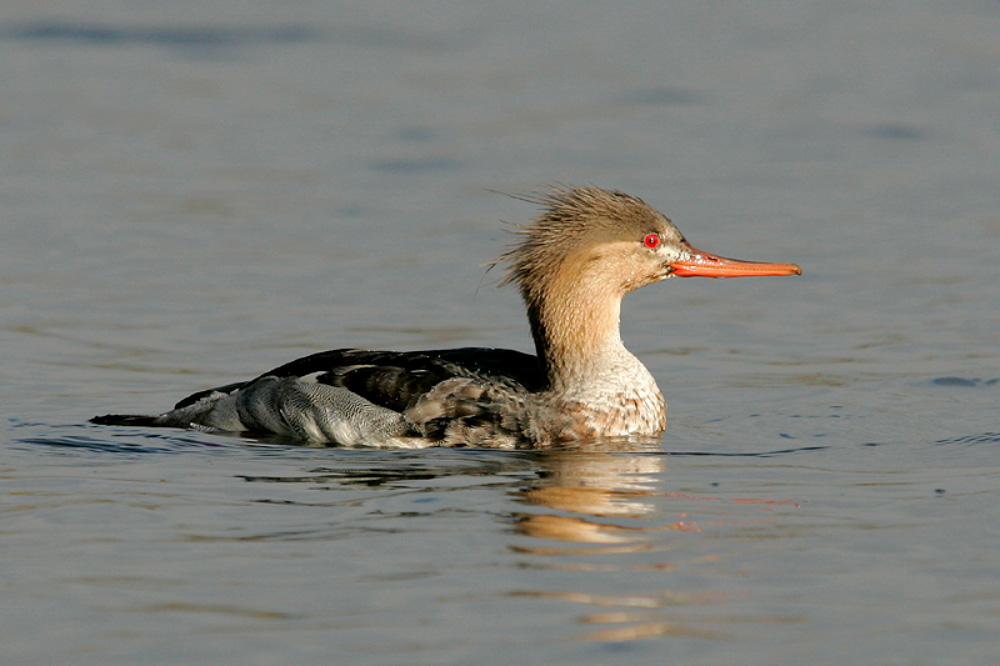
Red-breasted Merganser (Stoke-on-Trent, Staffordshire, 12 November 2011). This young male Red-breasted Merganser superficially resembles a female with its rusty orange head, diffuse neck contrasts and grey body. Note, however, the emergence of some adult male characters: some darker, green hues appearing in the head, more solid black-and-white patterning in the upperparts and a bright red eye (Steve Seal).
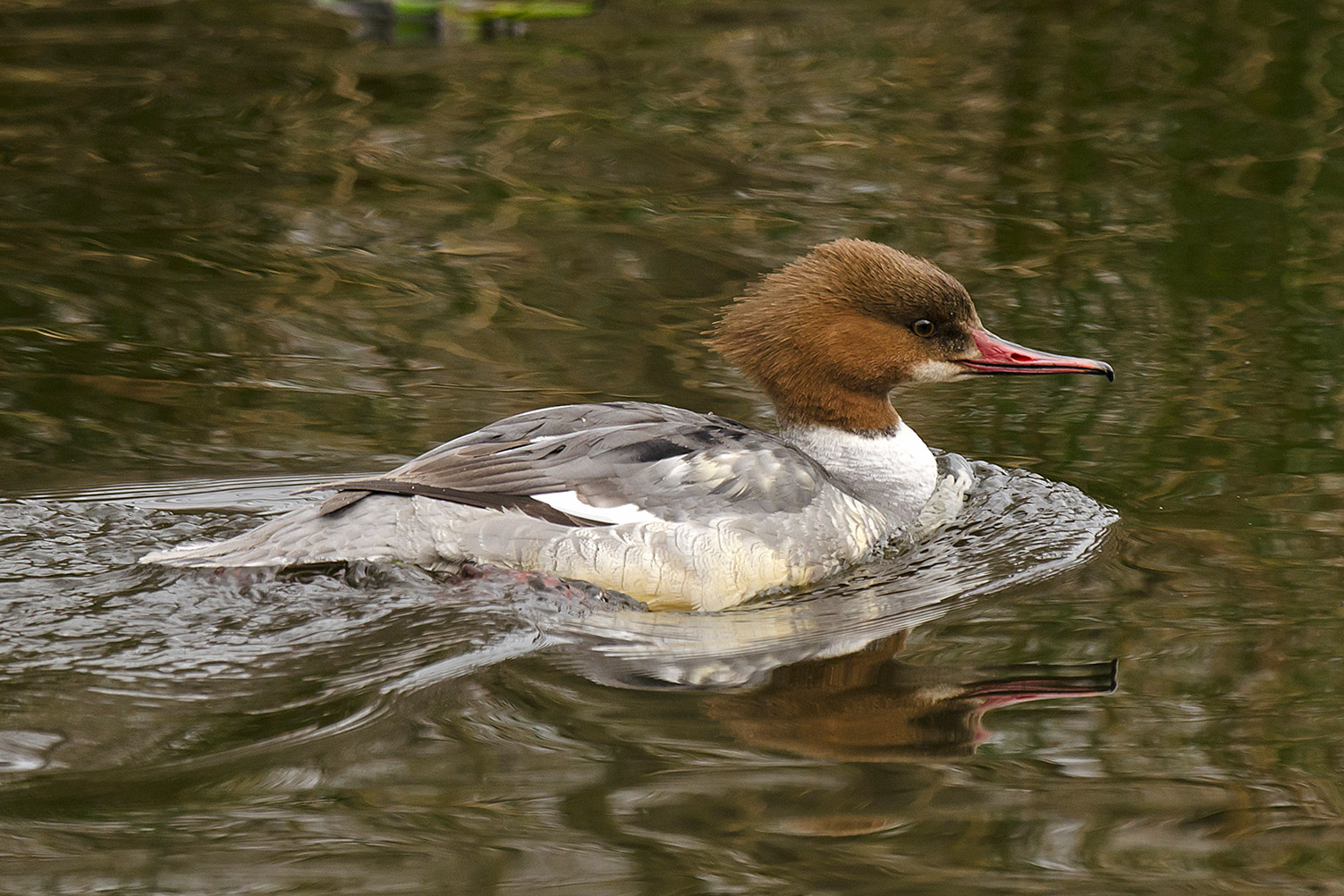
Goosander (Mere Sands Wood LWT, Lancashire, 9 March 2012). With its sharply contrasting rusty orange head and neat white throat, this Goosander closely resembles a female. However, there is some darker feathering appearing in the face, the tertials are suffused brown and white patches are appearing in the flanks. These suggest that this bird is in fact a young male (Steve Young /www.birdsonfilm.com).
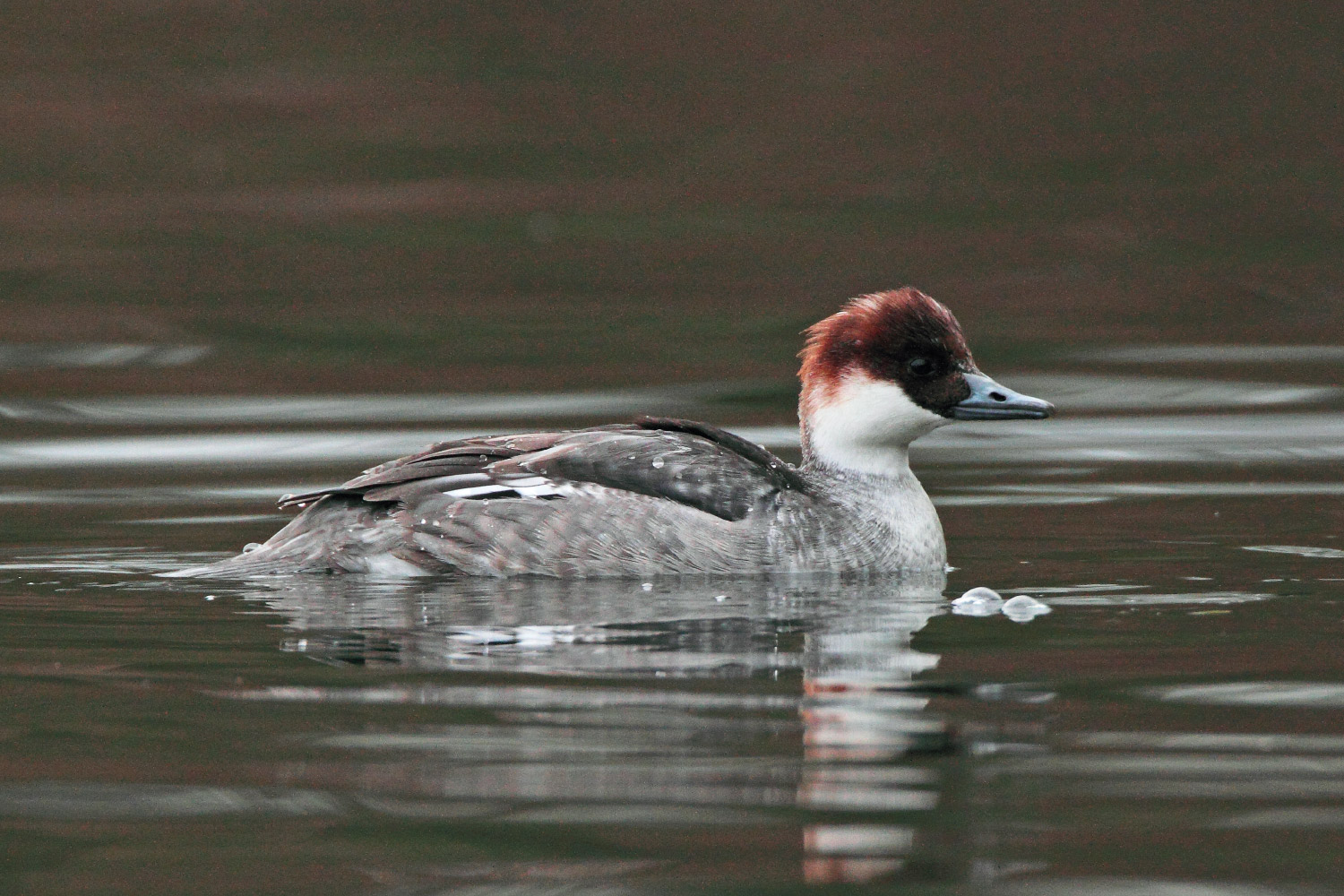
Smew (Stoke-on-Trent, Staffordshire, 14 December 2014). The dark orange cap, white chin and throat and grey body of this Smew are all characters of birds in female-type plumages. The dark lores and 'fore-face' here indicate that this bird is likely to be either an adult female or a young male, while the suggestion of white feathering within the dark cap points strongly towards the latter (Jim Almond).
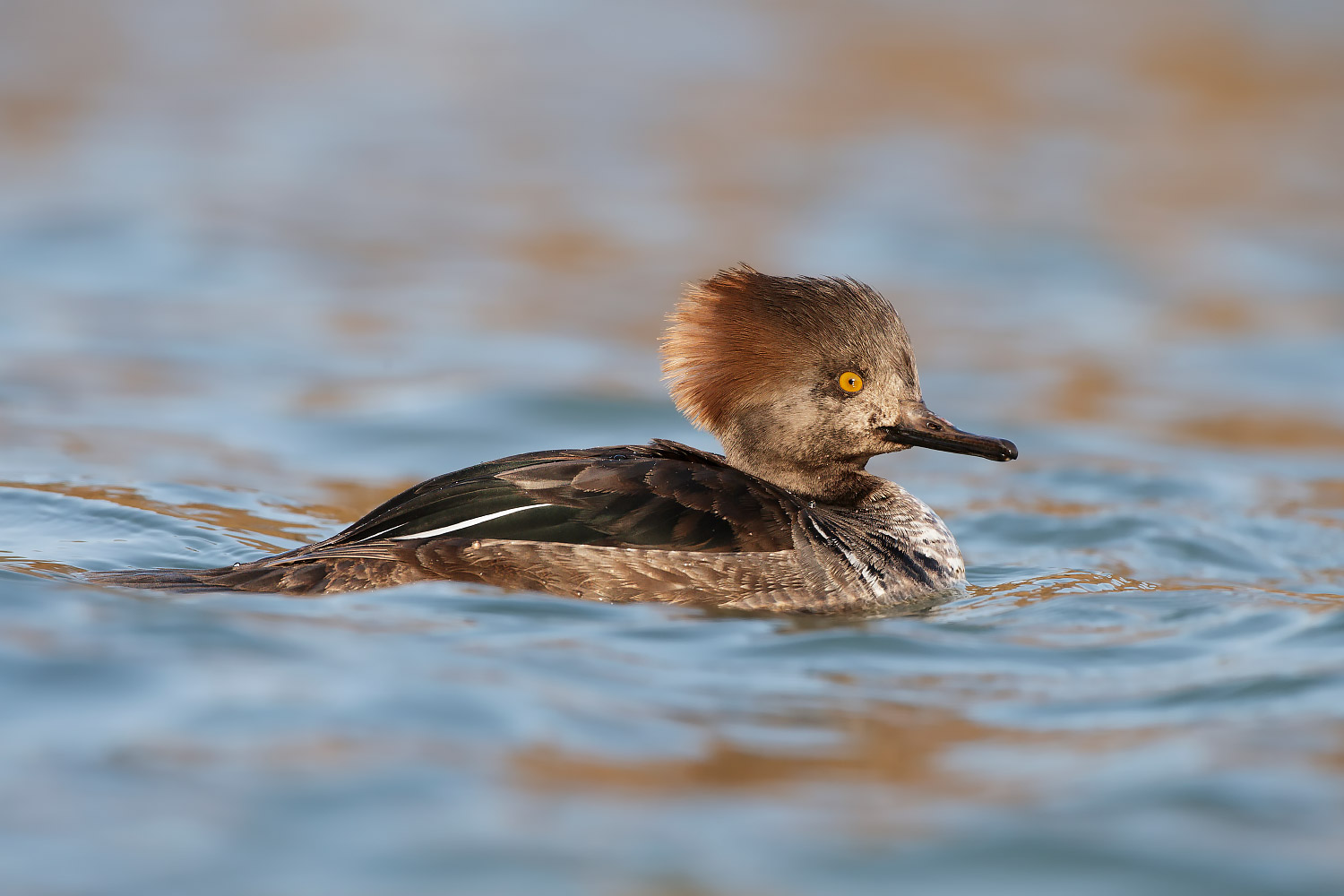
Hooded Merganser (Texas, USA, 18 December 2016). This Hooded Merganser closely resembles a female, but the bill is dark, there is a suggestion of male patterning at the breast sides and the eye is a bright golden yellow. This latter feature in particular is a sure sign that the bird is male. Ageing Hooded Mergansers is tricky, however, and best resolved by reference to the wing pattern (Nate Chappell / www.birdimagency.com).
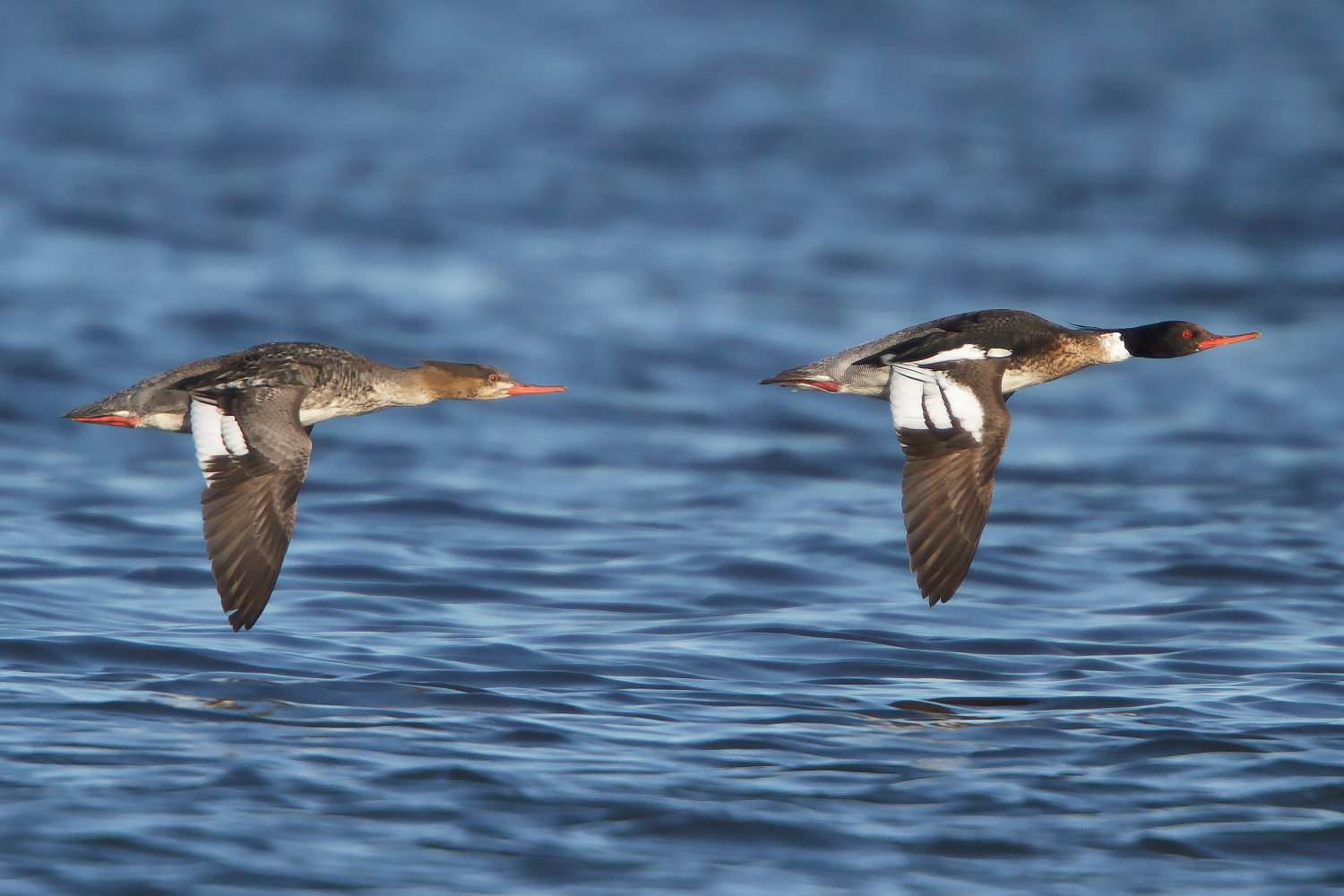
Red-breasted Merganser (Manitoba, Canada, 20 June 2011). Flying sawbills show dramatic colour and tonal contrasts, not least because of striking white patches in the wing which, although largely concealed when at rest, are highly obvious in flight. As shown here, Red-breasted Mergansers of both sexes show white in the secondaries and greater coverts, with adult males (as here) showing a more extensive patch which also covers the median coverts (Glenn Bartley / www.agami.nl).
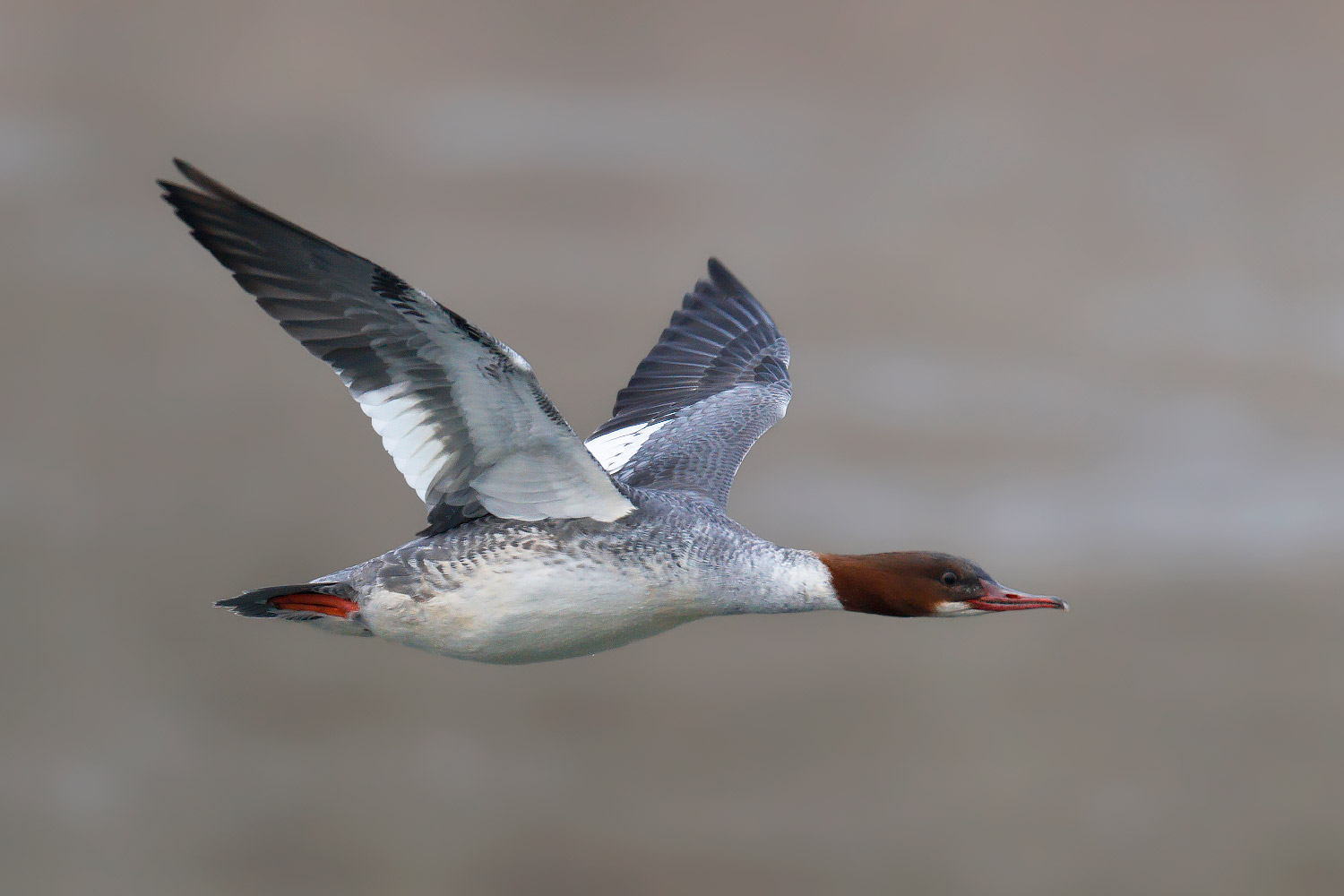
Goosander (Grevenbicht Sittard-Geleen, The Netherlands, 12 February 2012). This flying adult female Goosander shows similar white wing patches on the wing to those of Red-breasted Merganser, but is easily identified by its head and neck markings. Note in particular how sharp the dividing line is between the rusty orange head and the white foreneck – a degree of contrast never approached by Red-breasted Merganser (Ran Schols / www.agami.nl).
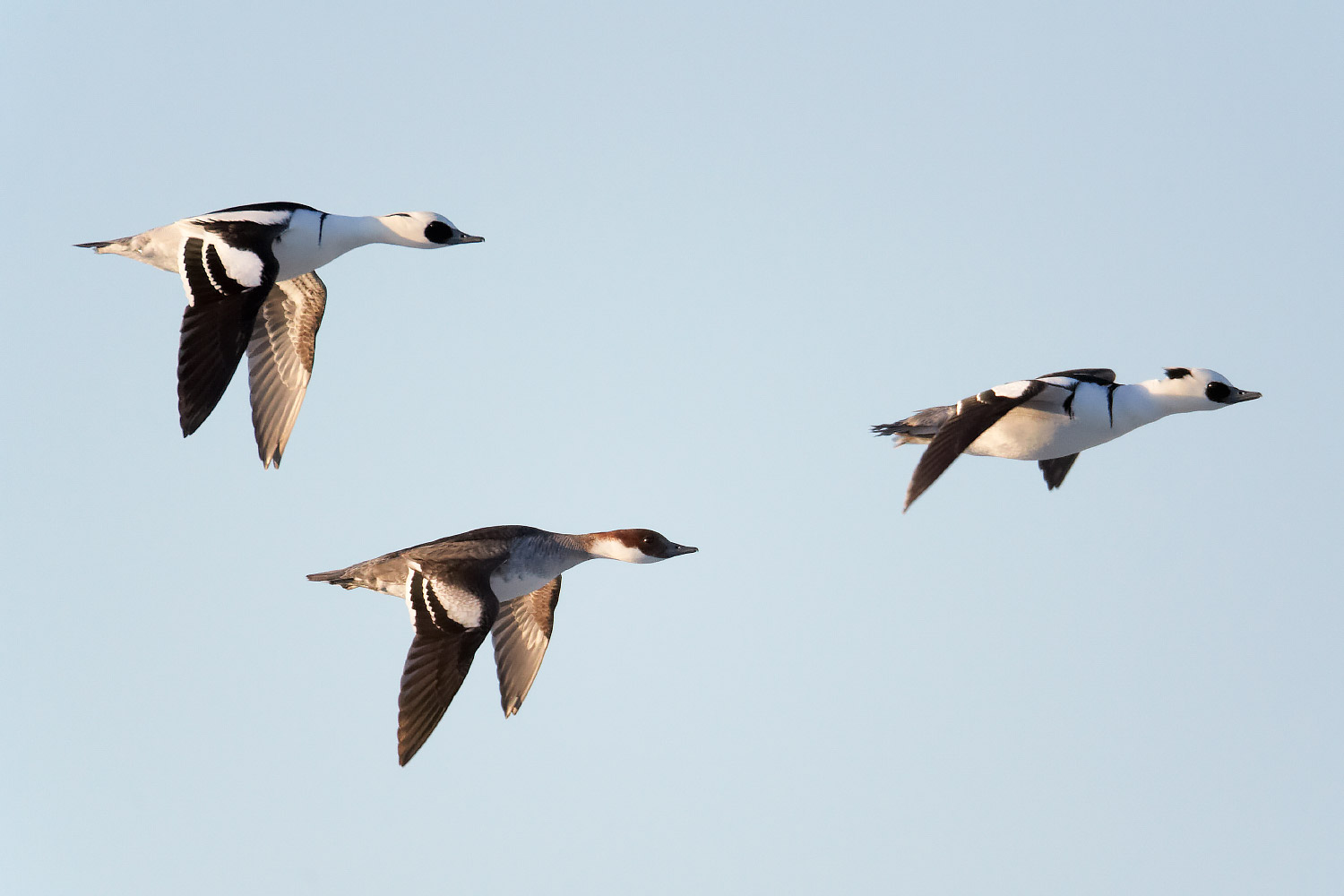
Smew (Utö, Finland, 23 March 2011). The white wing markings on flying Smew are rather different, comprising white patches on the median coverts with white tips to the otherwise dark greater coverts and secondaries. The female-type bird here has brown hues in the wing coverts and rather broad white wing-bars, suggesting that it is a young bird. It is hardly necessary to note these patterns, however, as Smew is, irrespective of its plumage type, a very distinctive species (Markus Varesvuo / www.birdphoto.fi).
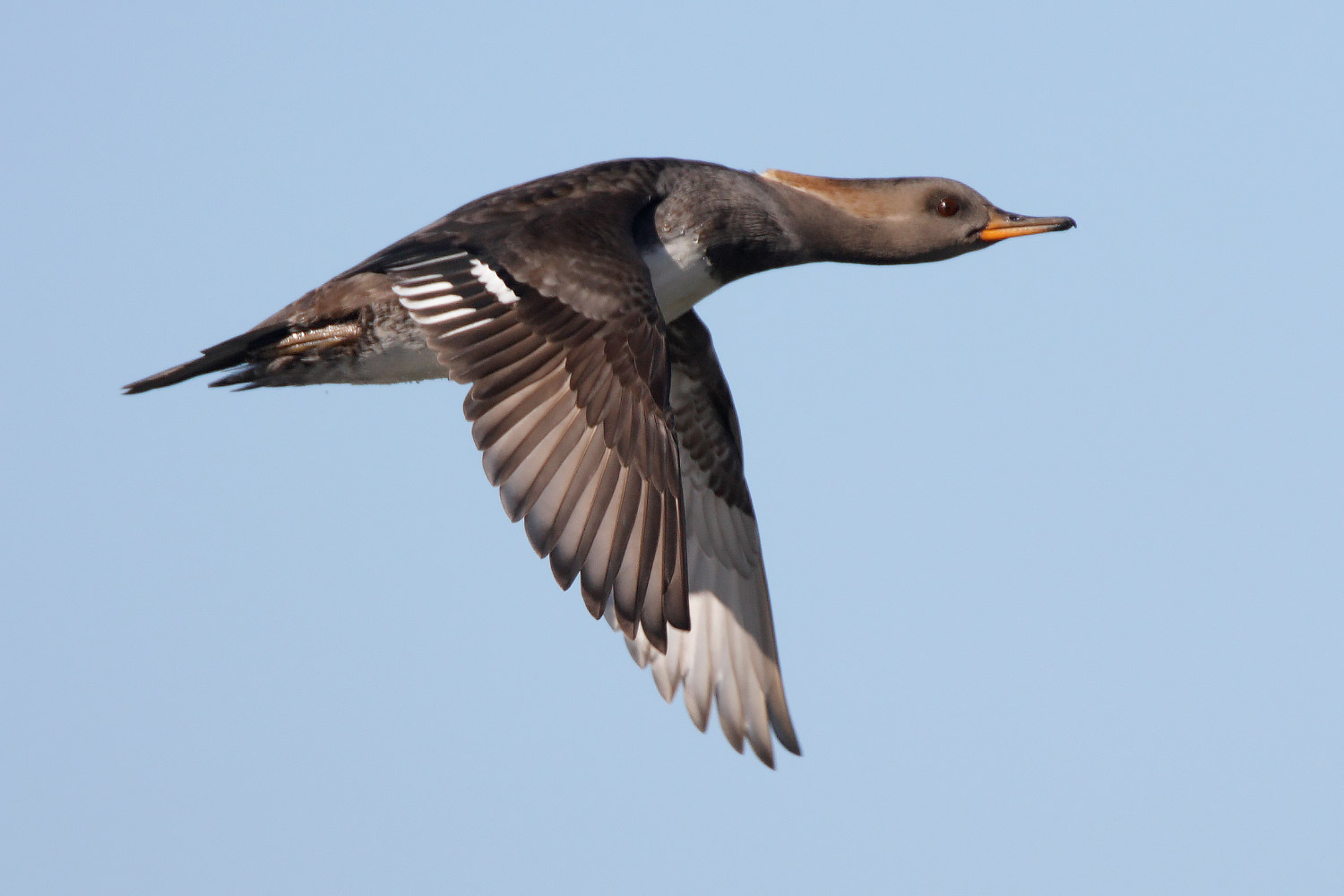
Hooded Merganser (New Jersey, USA, 22 November 2008). This female Hooded Merganser (note the dark eye and yellow in the bill) shows, compared to the other species featured here, very little white on the wing – just some white in the secondaries and white tips to the greater coverts. The breadth of the greater covert tips on this bird age it as an adult, young birds having a much narrower and less clear cut wing-bar (Mike Danzenbaker / www.agami.nl).
No comments:
Post a Comment